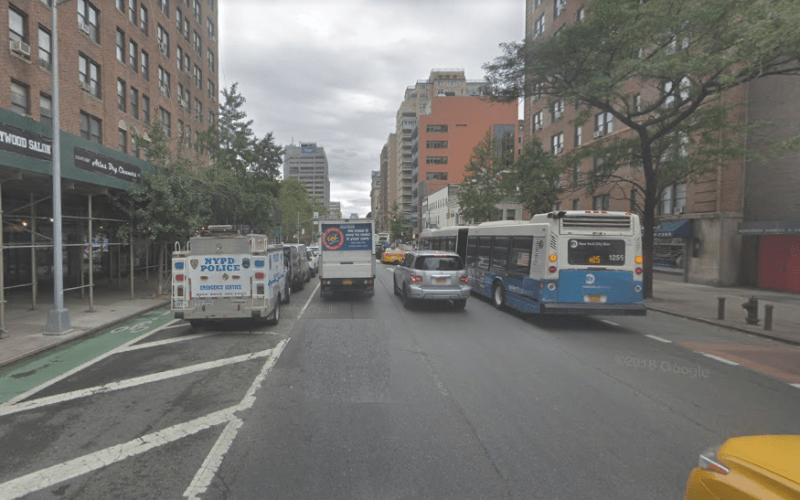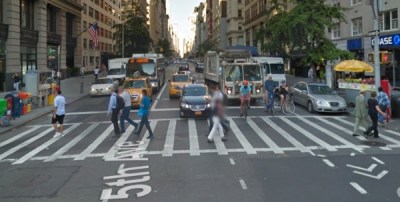Electeds Call for Wider Bike Lanes on Second Avenue and Beyond
A growing chorus recognizes the danger, lack of equity on roadways as the cycling boom mounts.

More room for bikes!
A chorus of local electeds are demanding the city widen vital pathways for cyclists amid the growing bike boom that kicked off last year — especially on Second Avenue — after a random count this week on the road showed that cars only outnumbered those on two wheels two-to-one, despite drivers getting almost 12 times as much space.
“I’m on my bike all the time; I take Second Avenue all the time,” said Manhattan Council Member Carlina Rivera, who represents portions of the route. “It’s incredibly busy with people who are biking recreationally as well as a ton of delivery workers. I think it would be a safe thing to do, it can get really, really crowded at certain intersections.”
Rivera was one of several officials who urged more bike space after Streetfilms’s Clarence Eckerson surveyed three intersections along Second Avenue, including 19th, 20th, and 22nd streets, during Tuesday’s rush hour. Eckerson found that there were 323 cars and trucks and 171 bikes, or 1.9 cars and trucks for every bike. The count highlighted the lack of equity for cyclists, who command a meager eight feet of space on the wide road, as compared to 100 feet for the movement and storage of cars.
The disparity prompted several Manhattan officials to demand an immediate fix, given the safety issues of so many cyclists — many of them working delivery cyclists — squeezing into the narrow lane on the vital artery.
What did we find in 20+ minutes on 2nd Avenue?
171 Bikes
323 Vehicles (cars, taxis, trucks, vans)
11 BusesDo we need a wider protected #bikenyc lane?https://t.co/lqA9QEOnJ3
— Streetfilms (Now 1,100 films strong!) (@Streetfilms) March 25, 2021
The politicians’ call to widen the Second Avenue bike lane comes as even more cyclists are expected to use it once the city recovers further from the pandemic and people start heading back to offices in East Midtown. Meanwhile, the East River Greenway, a major waterfront bike path, is being disrupted and will remain so for years on account of flood remediation and other construction, making the Second Avenue bike lane even more important.
“The Second Avenue bike lane is my route home, and it’s clear that we have seen a notable surge in bike use since COVID. Now is a good time for the Department of Transportation to commit to expanding bike lanes in areas of heavy usage,” said Manhattan Council Member Keith Powers.
Manhattan Borough President Gale Brewer went even further, telling Streetsblog that the Second Avenue bike lane is clearly needs a revamp given just how many cyclists now rely on it daily.
“The Second Ave bike lane, installed over a decade ago, has served us usefully but is flawed and must be updated. It’s time we move into a new generation of protected bike lanes in New York City that are wider, and more importantly, better protected,” said Brewer.
Comptroller Scott Stringer, a candidate for mayor, said he has “repeatedly urged the expansion of safe-cycling infrastructure throughout the city,” and “supports wider bike lanes on Second Avenue and throughout the five boroughs to serve increased traffic volume, delivery workers, and to support the transition to cargo bikes,” according to his spokesperson Hazel Crampton-Hays.

But Stringer wasn’t the only mayoral candidate to jump on the bandwagon.
“Widening the Second Avenue bike lane is a great step toward making Manhattan more bike-friendly,” said Andrew Yang.
The city has little choice but to curtail the space for cars if it wants to reach its street-safety goals.
“If the city wants to prioritize sustainable modes like buses and bikes, and to keep essential material traffic moving via truck, the place to find capacity to create a wider bike lane is from passenger cars,” said Bike New York’s Jon Orcutt.
Orcutt, who worked under former Mayor Bloomberg as the DOT’s policy director, said that Second Avenue could use more than just a wider bike lane. He suggested that the city turn its east-side parking lane into a deliveries-only lane, and that meters should be converted to “commercial only” — a plan that would complement the city’s forthcoming congestion-pricing scheme, which is expected to reduce the number of cars in Manhattan’s central business district.
It’s not just Second Avenue on the East Side that is experiencing a biking surge — bike traffic on the East River bridges also has soared since last spring. Streetsblog reported last October that the number of cyclists pedaling on weekdays across the four spans in October had jumped 30 percent compared to last October, while the number of people driving over them had fallen by 13 percent, according to DOT data. On weekdays, a similar pattern obtained. In September, 26,773 cyclists headed into Manhattan, compared to 22,132 in 2019, a hike of 20 percent. In October, 25,537 bikers crossed the East River compared to 19,614 the previous year — for growth of 30 percent, according to the DOT.
The surge — and a concerted campaign by Transportation Alternatives activists — helped push the de Blasio administration to announce one of the city’s biggest infrastructure changes of the mayor’s seven-year tenure: its promise to give cyclists more space on the dangerously overcrowded Brooklyn Bridge by taking a lane away from cars and creating a two-way, protected bike lane on the Manhattan-bound side of the span.
Under questioning from Streetsblog on Thursday, Mayor de Blasio said that the administration is “open” to widening the Second Avenue bike lane, along with other vital corridors where more people are riding, if the demand necessitates it, despite their being proof of increased demand.
“We’ve been expanding bike lanes intensely all over the city, and if there’s more and more bike usage, it makes sense to meet that and address it,” de Blasio said during his daily press briefing. “So, I’m certainly open. I want to see people as much as possible out of their cars, into mass transit, on bikes, as many options as possible for so many reasons, for fighting global warming, for reducing congestion, for so many reasons.”
Advocates jumped on that.
“Mayor de Blasio talked again today about wanting to get more people out of their cars,” said Cory Epstein, a spokesperson for Transportation Alternatives. “Spring is here, there’s only eight months left in his term, and he shouldn’t delay any longer.”
Epstein likened the widening of the Second Avenue bike lane — in a good way — to the traffic phenomenon of induced demand, which describes how car drivers flock to roadways that have been widened, which only ends up restoring the congestion that the widening project sought to relieve in the first place. In the case of bikes, however, ever-widening space for safe and clean cycling is a good thing.
“He can induce demand literally overnight by building bigger and better bike lanes on Second Avenue and across the city,” Epstein said.
